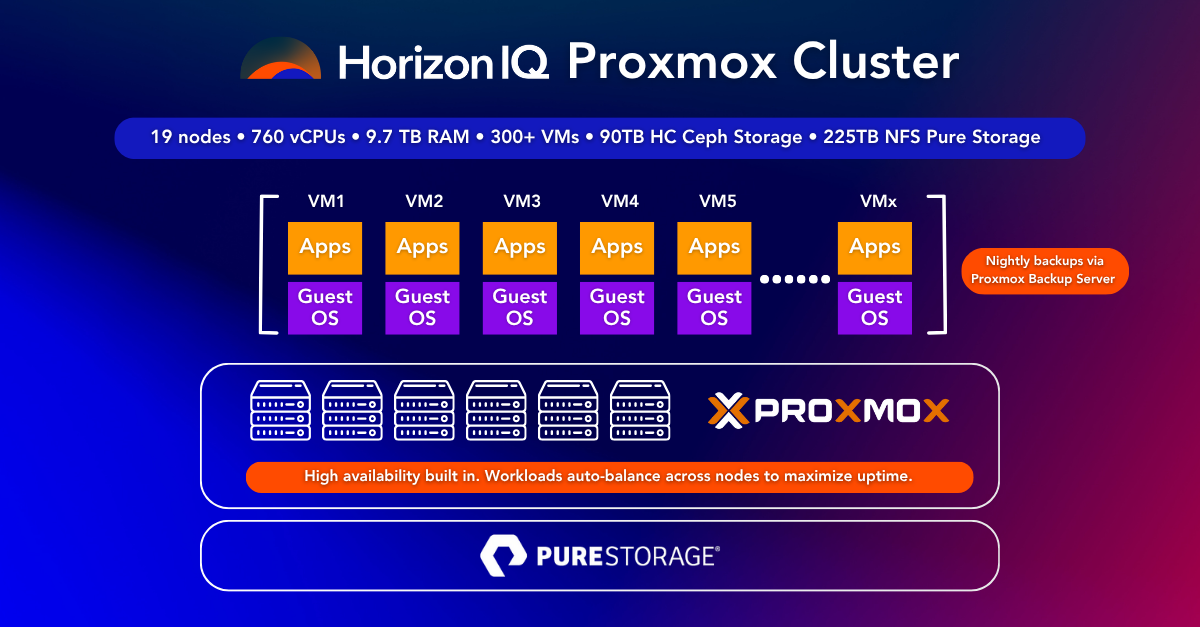
Building Enterprise-Grade Private Clouds with Proxmox VE
Location: Chicago, Illinois
Project: VMware Migration and Private Cloud Deployment with Proxmox VE
Applications: Affordable, scalable virtualization for secure, reliable infrastructure management
Overview
At HorizonIQ, we don’t just design high-performance infrastructure for clients—we rely on it ourselves. To support internal engineering, product development, and mission-critical operations, we transitioned from VMware to a private cloud powered by Proxmox VE, purpose-built for enterprise flexibility, control, and scalability.
Today, our platform runs hundreds of VMs across production, staging, and infrastructure environments, backed by a 19-node high-availability cluster and hyper-converged Ceph storage. It proves that open-source virtualization—when properly architected—can match enterprise requirements without proprietary constraints or runaway costs.
Why We Chose Proxmox
The Broadcom acquisition triggered a seismic shift in the VMware ecosystem. Between steep licensing hikes and inflexible contract terms, our environment became unsustainable. We needed a platform that could:
-
Reduce infrastructure costs
-
Eliminate rigid licensing models
-
Retain high availability and ease of use
Proxmox ticked every box. Its vCenter-like UI reduced the learning curve, QEMU-based virtualization provided proven performance, and its open-source model enabled the customizations that other hypervisors restrict.
About the HorizonIQ Proxmox Cluster
To meet internal demand, we built a Proxmox cluster capable of scaling compute and storage without major reconfiguration. The cluster supports over 300 VMs, backed by:
-
760 vCPUs and 9.7 TB RAM
-
90 TB of distributed, redundant Ceph storage
-
225 TB of flash-backed storage for latency-sensitive workloads
-
Hyper-Converged Storage: Distributed Ceph (RBD) storage delivers redundancy and high throughput for VM workloads.
-
High Availability: Proxmox HA automatically restarts VMs on surviving nodes in case of failure (just as VMware does), ensuring continuity.
-
Continuous Backups: Backup frequency varies by workload importance, with support for deduplication and compression via Proxmox Backup Server.
-
Intelligent Resource Placement: Anti-affinity rules and cluster-wide scheduling help distribute compute load and reduce resource contention.
Key Features
The Challenge
As our internal services grew, VMware’s licensing friction and infrastructure overhead became an operational bottleneck. VMware licensing for 1,484 internal cores, at a standard rate of $350/core per year, would have cost approximately $519,400 per year. Even at a discounted rate of $192.50/core/year, the cost would have been $285,640 annually. We needed:
- Predictable, flat-rate costs
- Less dependency on complex support systems
- A flexible platform for varied VM workloads
- The ability to scale infrastructure rapidly
Rather than a simple lift-and-shift, we used this opportunity to build a future-proof foundation for our evolving needs and those of our customers.
The Migration: VMware to Proxmox
To minimize disruption and retain rollback options, we used a temporary migration LUN to ensure a clean, controlled transition with rollback capability.
Step 1: Cluster Preparation
We created a shared migration datastore on HorizonIQ’s network storage and attached it to both vSphere and Proxmox clusters, enabling cross-platform disk access.
Step 2: VM Preparation
Each virtual machine was cleaned and prepped by:
- Uninstalling VMware Tools
- Installing QEMU Guest Agent
- Removing all existing snapshots
Step 3: Migration Execution
For each VM:
- We performed a storage vMotion to move all disks onto the migration LUN.
- A corresponding Proxmox VM was created with identical specs.
- The VM was shut down in vCenter, and its VMDK files were copied into the new Proxmox directory.
- The VM was booted in Proxmox to confirm operation.
- Disks were then live-migrated to their permanent Ceph-based destination and converted to QCOW2 format.
- Once validated, the original VM was removed from vCenter.
This phased method allowed us to maintain control, validate each workload, and preserve rollback options at every stage, resulting in a smooth and minimally disruptive cutover.
Looking to migrate without overlap costs?
Migration shouldn’t drain your budget. With HorizonIQ’s 2 Months Free, you can move workloads, skip the overlap bills, and gain extra time to switch providers without double paying.
Get 2 Months FreeImplementation & Results
Since migrating to Proxmox, the most significant impact has been on cost efficiency.
Our Proxmox environment, including support, now runs at $15,000/year, resulting in a cost reduction of 94%.
- Operational Continuity: No performance degradation compared to VMware.
- Simplified Management: Unified interface for VMs, containers, backups, and storage.
- Rapid Provisioning: Dev/test environments now spin up in minutes.
- Resilience: While HA and backups operate just as reliably as before, the cost, simplicity, and openness have improved substantially.
Beyond cost savings, we’ve also seen meaningful improvements across day-to-day operations:
Looking Ahead
We’re expanding automation and orchestration capabilities within Compass, our infrastructure management portal. Upcoming initiatives include:
- VM provisioning and node scaling
- Hybrid infrastructure orchestration
- Monitoring and access control from a single interface
Future roadmap initiatives focus on AI workload support, disaster recovery capabilities, and continuing to deliver reliable infrastructure without vendor lock-in. With Proxmox as the foundation, we’re building the infrastructure our customers need: resilient, responsive, and cost-efficient.
